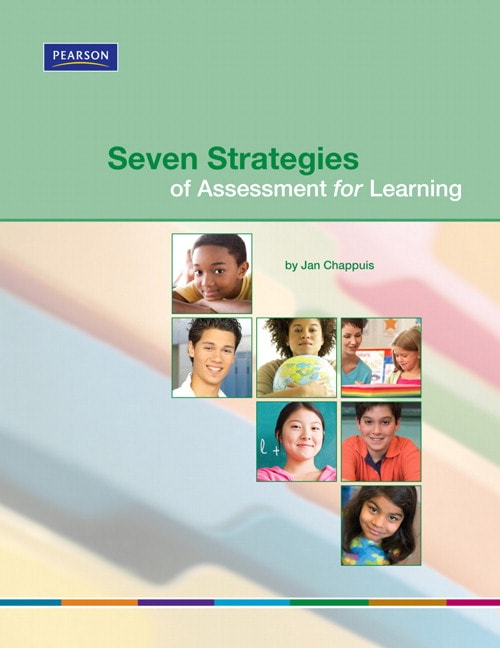
45.00$
Test Banks & Solution Manual
- Test Banks for Textbooks. Save money on TEST BANKS
- Anticipate the type of the questions that will appear in your exam.
- Delivery is INSTANT. You can download the files IMMEDIATELY once payment is done.
- Our test banks can help! All test banks are Downloads-take them with you to study!
- YOU GET ALL OF THE CHAPTERS. Each Test Bank follows your textbook.
- Ace Your Exams with Us! We are Students Helping Students Pass.
- Customer Service 24/7
Category : Higher Education
Table of Contents CHAPTER 1: Formative Assessment and Assessment for Learning........................................1 What Is Formative Assessment?..............................................................................................................4 Summative Assessment.....................................................................................................................5 Formative or Summative?.................................................................................................................6 What Gives Formative Assessment Its Power?......................................................................................7 Formative Assessment in Teachers’ Hands......................................................................................9 Formative Assessment in Students’ Hands....................................................................................10 Seven Strategies of Assessment for Learning......................................................................................11 Where Am I Going?.........................................................................................................................11 Where Am I Now?...........................................................................................................................12 How Can I Close the Gap?...............................................................................................................13 Conclusion ............................................................................................................................................14 The Chapters Ahead.............................................................................................................................14 CHAPTER 2: Where Am I Going? Clear Targets.......................................................................15 Strategy 1: Provide students with a clear and understandable vision of the learning target............22 Converting Knowledge and Reasoning Learning Targets to Student-friendly Language....................................................................................................................22 Defining Quality for Reasoning, Performance Skill, and Product Learning Targets....................28 When to Share the Learning Target................................................................................................41 Checking for Understanding of the Intended Learning.................................................................41 Strategy 2: Use examples and models of strong and weak work.........................................................42 Knowledge and Reasoning Learning Targets: Selected Response Items......................................42 Reasoning, Performance Skill, and Product Learning Targets: Performance Assessment Methodology..........................................................................................43 Examples of Strategies 1 and 2 with Elementary Students.................................................................46 Inference Scenario..........................................................................................................................47 Conclusion.............................................................................................................................................51 CHAPTER 3: Where Am I Now? Effective Feedback .............................................................53 Characteristics of Effective Feedback .................................................................................................56 1. Effective feedback directs attention to the intended learning.................................................57 2. Effective feedback occurs during learning.................................................................................68 Other Feedback Variables to Consider.................................................................................................69 3. Effective feedback addresses partial understanding.................................................................70 4. Effective feedback does not do the thinking for the student....................................................72 5. Effective feedback limits correctives to what students can act on...........................................74 Suggestions for Offering Feedback.......................................................................................................75 Picture or Symbol Cues...................................................................................................................75 Assessment Dialogues.....................................................................................................................78 Peer Feedback.......................................................................................................................................83 Scaffolding a Peer Feedback Conference.......................................................................................84 Peer Response Groups....................................................................................................................87 Conclusion.............................................................................................................................................92 CHAPTER 4: Where Am I Now? Self-assessment and Goal Setting......................................93 Impact of Self-assessment on Student Achievement...........................................................................96 Three Parts: Self-assessment, Justification, and Goal Setting.............................................................99 Quick Self-assessment Ideas.................................................................................................................99 Self-assessment and Goal Setting with Selected Response and Constructed Response Tasks...............................................................................................................103 Before: Targeting the Learning.....................................................................................................103 During: Self-assessment While Completing an Assignment, Quiz, or Test ...............................109 After: Self-assessment and Goal Setting Using the Results of a Formative Quiz or Test..........111 Self-assessment and Goal Setting with Performance Assessment Rubrics......................................117 Prerequisites.................................................................................................................................117 Ways to Format Rubric Text.........................................................................................................118 Using the Rubric Itself...................................................................................................................119 Goal Setting.........................................................................................................................................123 Helping Students Set Specific, Challenging Goals.......................................................................124 The Goal-setting Conference........................................................................................................126 Conclusion...........................................................................................................................................127 CHAPTER 5: How Can I Close the Gap? Focused Teaching and Revision.........................129 Scaffolding with Selected Response and Short Constructed Response Items.................................132 Identifying and Using Typical Misconceptions and Reasoning Errors .......................................132 Multiple-choice Items as Teaching Tools......................................................................................134 Using Graphic Organizers as Teaching Tools...............................................................................139 Scaffolding with Performance Assessment Tasks and Rubrics.........................................................141 Creating Focused Tasks.................................................................................................................141 Practicing One Criterion at a Time...............................................................................................145 Conclusion ..........................................................................................................................................146 CHAPTER 6: How Can I Close the Gap? Tracking, Reflecting On, and Sharing Learning........................................................................................................................149 Students Keeping Track of Their Learning........................................................................................152 Recording Progress.......................................................................................................................152 Keeping Learning Journals............................................................................................................153 Collecting Samples of Work...........................................................................................................156 Students Reflecting on Their Learning...............................................................................................159 Reflecting on Growth.....................................................................................................................159 Reflecting on a Project..................................................................................................................162 Reflecting on Achievement...........................................................................................................164 Students Reflecting on Themselves as Learners..........................................................................165 Students Sharing Their Learning .......................................................................................................167 Writing to Others..........................................................................................................................167 Participating in Conferences.........................................................................................................169 Conclusion ..........................................................................................................................................174 Closing Thoughts................................................................................................................................174 Appendix A: Student-friendly Scoring Rubrics......................................................................175 Appendix B: Reproducible Forms...........................................................................................199 Bibliography ...............................................................................................................................255 Table of Contents
What is Test Bank?
The test bank is a guide for testing and exams. It contains a lot of questions with their correct answers related to an academic textbook. Test banks usually contain true/false questions, multiple choice questions, and essay questions. Authors provide those guides to help instructors and teachers create their exams and tests easily and fast. We recommend all students to download the sample attached to each test bank page and review them deeply..
What is Solutions Manual?
The solutions manual is a guide where you can find all the correct answers (odd and even) to your textbooks’ questions, cases, and problems.
Can I get a sample before buying a Test Bank or Solutions Manual?
Samples are attached to each test bank and solutions manual page at our website. We always recommend students and instructors to download the samples before placing orders. At MANUALS1 we offer a complete sample chapter for each product.
Can I download my files immediately after completing the order?
Yes. Our system will grant you an access to download your files immediately after completing the order.
How will I download my product?
You will receive an email from testbanky that contains the download link.
If you could not download your product for any reason, contact us and we will solve the issue immediately.
No comments:
Post a Comment